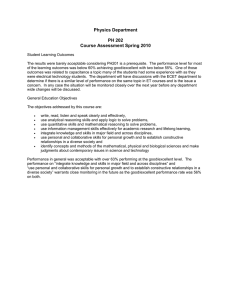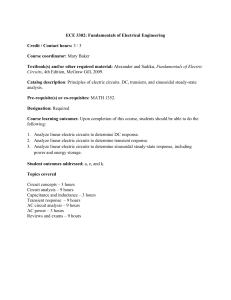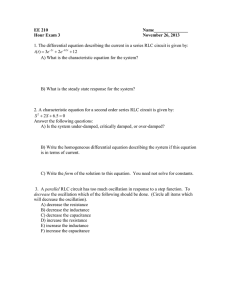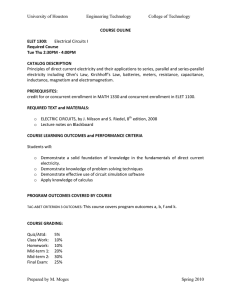CHAPTER 4. TRANSIENT ANALYSIS OF ENERGY STORAGE
advertisement
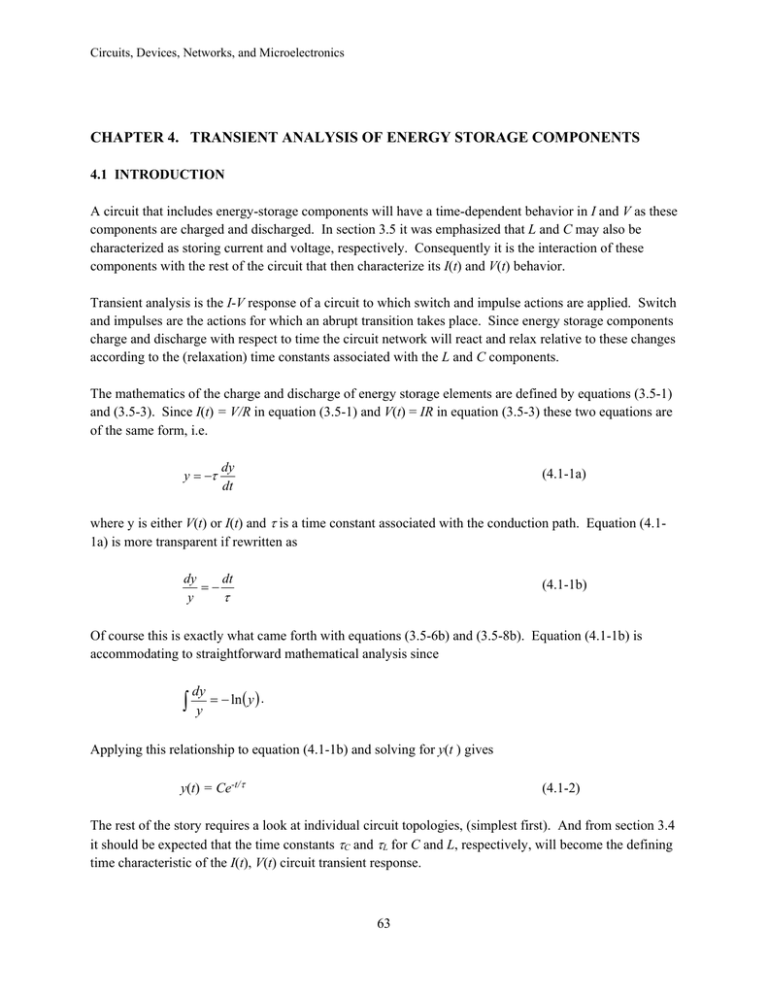
Circuits, Devices, Networks, and Microelectronics CHAPTER 4. TRANSIENT ANALYSIS OF ENERGY STORAGE COMPONENTS 4.1 INTRODUCTION A circuit that includes energy-storage components will have a time-dependent behavior in I and V as these components are charged and discharged. In section 3.5 it was emphasized that L and C may also be characterized as storing current and voltage, respectively. Consequently it is the interaction of these components with the rest of the circuit that then characterize its I(t) and V(t) behavior. Transient analysis is the I-V response of a circuit to which switch and impulse actions are applied. Switch and impulses are the actions for which an abrupt transition takes place. Since energy storage components charge and discharge with respect to time the circuit network will react and relax relative to these changes according to the (relaxation) time constants associated with the L and C components. The mathematics of the charge and discharge of energy storage elements are defined by equations (3.5-1) and (3.5-3). Since I(t) = V/R in equation (3.5-1) and V(t) = IR in equation (3.5-3) these two equations are of the same form, i.e. y dy dt (4.1-1a) where y is either V(t) or I(t) and is a time constant associated with the conduction path. Equation (4.11a) is more transparent if rewritten as dy dt y (4.1-1b) Of course this is exactly what came forth with equations (3.5-6b) and (3.5-8b). Equation (4.1-1b) is accommodating to straightforward mathematical analysis since dy ln y . y Applying this relationship to equation (4.1-1b) and solving for y(t ) gives y(t) = Ce-t/ (4.1-2) The rest of the story requires a look at individual circuit topologies, (simplest first). And from section 3.4 it should be expected that the time constants C and L for C and L, respectively, will become the defining time characteristic of the I(t), V(t) circuit transient response. 63 Circuits, Devices, Networks, and Microelectronics 4.2 SINGLE TIME-CONSTANT TRANSIENT ANALYSIS Capacitance: The simplest option is one in which charge and discharge of a capacitance is toggled by a switch, as represented by figure 4.2-1. Figure 4.2-1. Charge/discharge of capacitance through a resistance. For which the flow of charge is then I dQ d CV dt dt C dV dt (4.2-1) Using equation analysis by KVL and equation (4.2-1) gives dV C R V (t ) dt V1 IR V (t ) (4.2-2) Equation (4.2-2) is a first-order linear equation in V(t) for which V is the voltage across the capacitance. It is of benefit to rewrite equation (4.2-2) as V V1 RC for which dV dV dt dt (4.2-3) = RC (4.2-4) The symbol reflects that this is of the form of a time constant. More than that, it is the characteristic time constant of the RC charge/discharge and might be subscripted as =C as was recognized in the previous chapter by equation (3.4-6b). Equation (4.2-3) can be reordered and simplified as dV dt dt V V1 RC 64 V t dV dt V V1 0 V (0) Circuits, Devices, Networks, and Microelectronics V V1 t ln V (0) V1 for which This result can be inverted and expressed in terms of its voltage profile as V V1 V (0) V1 e t (4.2-5) V1 is the voltage across the capacitance after a long time has elapsed otherwise denoted as V () . Consequently equation (4.2-5) takes on the limit form V V ( ) V (0) V () e t (4.2-6) Examining (4.2-6) at the limits, it should be evident that at t = 0 = V(0). And for t = ∞, V(t) = V(∞). The rest of the story lies in the exponential transition between the two limit states as defined by. The limits V(0) and V(∞) represent two toggle states. As identified by equation (4.2-6) the transitions between them are exponential as represented by figures 4.2-2(a) and 4.2-2(b) along with equations (4.2-7a) and (4.2-7b) respectively. Figure 4.2-2(a). RC network with input switch toggled to V1 = 0. Then V () 0 and V(0) = VB. For figure 4.2-2(a) and the values of V () and V(0) equation (4.2-6) gives V V (0)e t (4.2-7a) Equation (4.2-7a) represents exponential decay of V(t) to zero as indicated by the figure. 65 Circuits, Devices, Networks, and Microelectronics Figure 4.2-2(b). RC network with switch toggled to VB = 10V. Then V () V B and V(0) = 0. For figure 4.2-2(b) and the values of V () and V(0), equation (4.2-6) gives V V B 1 e t (4.2-7b) which reflects an exponential rise to VB as indicated by the figure. Switch actions also allow stored charges to redistribute, as represented by figure 4.4-3. Figure 4.4-3. Charge redistribution between two capacitances. The total charge on the two capacitances before switch closure is QTOT Q1 Q2 C1V1 C 2V2 Charges moves but no charge escapes when the switch closes. And so QTOT V x C TOT V x C1 C 2 Consequently the voltage Vx that results after switch closure is Vx Q TOT C TOT C1V1 C 2V 2 C1 C 2 (4.2-8) Consider the following example: 66 Circuits, Devices, Networks, and Microelectronics EXAMPLE 4.2-1: Two capacitances within an IC (integrated circuit) are connected by a transistor switch. Determine (a) the equilibrium voltage that results after the switch is closed and (b) total stored energy before and after. SOLUTION: (a) Using equation (4.2-8) Vx C1V1 C 2V 2 C1 C 2 10 3 40 0.25 = 0.8V 10 40 (b) The energies before and after closing the switch are given by 1 1 C1V12 C 2V 22 2 2 1 1 = 45fJ +1.25fJ 10 3 2 40 0.25 2 2 2 1 1 w(after) C1 C 2 V x2 10 40 0.8 2 16.0fJ 2 2 w(before) w1 w2 = 46.25fJ (Where did the missing energy go?) Example 4.2-1 should raise the question about the fact that energy (in the amount of approximately 30fJ) seems to have vanished!!? Since the components are ideal the question is valid. But in fact the transistor switch will have an internal resistance. And so the missing energy has dissipated in the switch resistance. Integrated circuits take advantage of this fact and can use an infra-red scanner to see which switches (transistors) light up during a logic sequence. This phenomenon then provides a means to debug the actual switch action that is taking place. The rest of the story is that switches may do more than simply toggle a source ON/OFF. They may also act as a transfer connection between two distinct and separate RC circuits, each with a different time constants and with different boundary conditions. Consider the following example. EXAMPLE 4.2-2: Solve for the quantities indicated and determine the analytical response for VC(t). SOLUTION: V(0) = 10V by inspection. 67 Circuits, Devices, Networks, and Microelectronics The time constant (not asked) that charges capacitance C to VB is = 20k x 50pF = 1.0s Voltage V ( ) = 2.0V (by inspection) due to charge redistribution. i.e V () = 80k x 40pF = 3.2s 10 50 200 0 50 200 (**where the 40pF is due to 50pF in series with 200pF) The energies are: wC(before) 1 50 10 2 2 1 wC(after) 50 2 2 2 1 C1V12 2 1 C1V 22 2 1 w2(after) C 2V22 2 wC(after) so wTOT(after) 80k resistance. w2(after) 1 200 2 2 2 = 2.5nJ = wTOT(before) = 0.1nJ = 0.4nJ = 0.1nJ + 0.4nJ = 0.5nJ and this amount of energy is dissipated in the By equation (4.2-6) the analytical behavior after the switch is flipped is V V ( ) V (0) V () e t V = 2 + 8e-t/ where = 3.2s Inductance: Whereas capacitances represent charge storage and the energy associated with stored charge, inductances represent flux storage and the energy associated with stored magnetic flux. Similar transient response result when an inductance is toggled by a switch. The distinction is that inductance reacts to a change of current through it by a responding with a reaction voltage (induced voltage) of V L dI dt (4.2-9) This behavior is acknowledged by Faraday’s law of magnetic induction. Comparing equation (4.2-9) to equation (4.2-1) for the capacitance, it is evident that the components are alike but complementary. The polarity of the induced potential will act to oppose the change of current. If applied to a circuit as represented by figure 4.2-4 similar mathematics to that of the charge/discharge of the capacitance will result. 68 Circuits, Devices, Networks, and Microelectronics Figure 4.2-4. Charge/discharge of an inductance through a resistance. Like the capacitance the circuit symbol for an inductor resembles its basic construct, i.e. loops of wire enclosing energy in the form of magnetic field. The analytical interpretation of the circuit of figure 4.2-4 may be analyzed by KVL as V1 IR V L (t ) IR L dI dt (4.2-10) where the positive value for VL is due to the fact that it will react to oppose the current through the resistance in accordance with Lenz’s law. Like that of the capacitance, equation (4.2-10) is a linear equation which can be rewritten as I V1 dI L dI R R dt dt (4.2-11) where the time constant is L/R (4.2-12) Equation (4.2-11) is of the same form as equation (4.2-3) and so the solution will be of the same form except in terms of current instead of voltage, i.e. I I 1 I (0) I 1 e t (4.2-13) where I1 = V1/R represents the current after a long time has elapsed. It is appropriate to adopt the same protocol as used for capacitance charge and discharge switching, i.e. I I () I (0) I ()e t (4.2-14) And in like manner to the capacitance, toggling the switch in an inductance loop will give transient behavior for I(t) as defined by the energy charge and discharge of the inductance. 69 Circuits, Devices, Networks, and Microelectronics Equation (4.2-14) shows that the RL transient response is entirely like that of its RC cousin. For the two toggle options of the switch the current through the inductance as a function of time is indicated by figures 4.2-5(a) and 4.2-5(b) with corresponding analytical responses given by (4.2-15a) and (4.2-15b). Figure 4.2-5(a). RL network with input switch toggled to V1 = 0. Then I () 0 , I(0) = VB/R . So according to equation (4.2-14) and the limit conditions identified by figure 4.2-5(a) I I ( 0) e t (4.2-15a) with exponential decay to zero as indicated by figure 4.2-5(a) Figure 4.2-5(b). RL network with switch toggled to VB = 10V. Then I () V B R , I(0) = 0. So according to equation (4.2-14) and the limit conditions identified by figure 4.2-5(b) I VB 1 e t R (4.2-15b) with exponential rise to VB/R as indicated by figure 4.2-5(b). The storage of energy by an inductance is similar to that of the capacitance except that it stores current, held in a set of loops by magnetic field. For the voltage V(t) induced across an inductance as it is charged by current I(t) the energy that it stores will be an integral of power p(t) = I(t)V(t) of the form 70 Circuits, Devices, Networks, and Microelectronics dI wL V (t ) I (t )dt L Idt dt 0 0 T T I = L IdI 0 1 2 LI 2 (4.2-16) If the geometrical interpretation of an inductance represented by equations (3.3-6) and (3.3-7) are applied to equation (4.2-16) then energy density equation (3.1-2) will result. 4.3 TRANSIENT ANALYSIS OF RLC TOPOLOGIES The next question should be ‘what if both an inductance and a capacitance are in the charge/discharge loop. They both store energy. But the principal distinction is that their energy storage forms are complementary. Consequently the discharge flow of energy from one will be absorbed by the other, and then there a predisposition to oscillate back and forth. This oscillation between the L and the C would hypothetically go on forever were it not for the presence of resistance, whether natural or applied, and which is a dissipative component and dampens the oscillation. Mathematical analysis confirms this behavior. It is second-order differential equation that resolves from the two benchmark RLC topologies, which are or generic form (1) series and (2) parallel reflected by figures 4.3-1(a) and 4.3-1(b), respectively Figure 4.3-1(a). RLC series topology. Figure 4.3-1(b). RLC parallel topology. The transient analysis is not unlike those entertained for the single C or single L. Consider a KVL assessment of the topology of figure 4.3-1(a), for which VS iR L The substitution i C di VC dt (4.3-1) dVC changes equation (4.3-1) to dt d dV dV V S C C R L C C VC dt dt dt 71 Circuits, Devices, Networks, and Microelectronics or (reorganizing) V S RC dV C d 2V C LC VC dt dt 2 This equation may be restated in the form of a second-order differential equation: VS d 2VC R dV C 1 VC LC L dt LC dt 2 (4.3-2) Alternatively but similarly, analysis of figure 4.3-1(b) by a nodal analysis at Vp gives dV P 1 t GV S GV P C V P dt dt L Taking the time derivative of this equation gives G dV S dV d 2V P V P G P C dt dt L dt 2 which simplifies to G dV S d 2V P G dV P V P C dt C dt LC dt 2 (4.3-3) Equations (4.3-2) and (4.3-3) are second-order differential equations in t of the homogeneous form d 2 x 2 dx x 0 dt 2 dt 2 (4.3-4) for which the coefficients are chosen with respect to time derivatives and time constants. The time constant is sufficient to bridge all of the character of the response and it related to the individual time constants L and C of the L and C components as 2 LC L RC R 2 L C or (4.3-5a) Of further mathematical convenience and interpretation can be restated in terms of (radian) frequency 0 1 (4.3-5b) which results in a more tractable as well as more descriptive differential equation of the form 72 Circuits, Devices, Networks, and Microelectronics d 2x dx 2 0 02 x 0 dt dt 2 In the time-honored way of solving ordinary differential equations, a WAG (wild-eyed guess) is assumed as the solution and then it is proven to be good by substitution back into the D.E. In this case the choice x(t) = Aest is made as the WAG, for which, taking derivatives, gives s 2 2 0 s 02 e st 0 (4.3-6) The WAG is confirmed for ( ) = 0, for which the quadratic equation will have roots s 0 j 0 1 2 j d (4.3-7) Equation (4.3-7) makes the assumption that < 1 is the more likely option, so the roots will almost always be complex. The solution to the quadratic equation given by (4.3-6) shows why the choice 20 for the middle term of generic equation (4.3-4) is elected. The quadratic coefficients 1, 2 0 , 02 are not only mathematically convenient but behaviorally appropriate. As should be expected for any quadratic, two parametric characteristics, and 0, are the consequence. 0 is called the characteristic (radian) frequency and is called the normalized damping coefficient. For the signal being a step response like that generated by switching action then VS is a constant, and one of two possible levels. In which case the response will be of the form x (t ) V (t ) V 0 e st V 0 e ( j d ) V 0 e t e j d (4.3-8) Equation (4.3-8) is of the form of an exponentially decreasing amplitude with an oscillation of (radian) frequency d and amplitude decay time constant R = 1/. This behavior is confirmed by a simulation rendition of figures 4.3-1(a) and (4.3-1(b) in response to a step impulse (same as a switch toggle). The results are shown by the figures (4.3-2(a)) and (4.3-2(b). Figure 4.3-2(a). RLC series topology with step impulse at input. The input is indicated by the dashed line. The output is riding on the input and shows a ringing effect. 73 Circuits, Devices, Networks, and Microelectronics Figure 4.3-2(b). RLC parallel topology with step impulse of same amplitude as that of series topology except reduced by factor of 4 to show ringing response. The response of an RLC circuit is not unlike that of one of its acoustic cousins in which a tap on a bell will give a ringing response that declines in amplitude with time constant R . If the amplitude time constant R is related back to the two topology options then 2 2 2 2 2 R 2 R R L G C 1 L 1 C for the series topology for the parallel topology So the amplitude decay constant R relates directly to component time constants according to the series/parallel RLC topology as Series RLC: R 2 L (4.3-9a) Parallel RLC: R 2 C (4.3-9b) And R (for both) (4.3-10) EXAMPLE 4.3-1: (a) Analyze the RLC series circuit shown and determine all of the relevant time constants (L, C, ,R). (b) Determine , d, and fd = 0.16d. (c) execute the circuit in pspice and extract d ,R andand compare to part (b). Figure E4.3-1(a): RLC series topology example. 74 Circuits, Devices, Networks, and Microelectronics (a) SOLUTION: (b) L L R = 10uH/50 = 0.2s = 200ns C RC = 160ps × 50 = 8.0ns L C = 200 8.0 = 40ns R 2 L = 2.0 × 0.2s = 0.4s 2 L = 40ns/(2 × 200ns) 0 1 = 1/40ns = 25Mr/s so d 0 1 2 = 0.1 = 25 1 0.12 = 24.88 Mr/s → fd = 0.16 × 24.88 (c) = 3.98MHz The circuit rendering in pspice is shown by figure E4.3-1(b). The cursors give the essential information. The difference between cursors on the time t = 0.252s scale shows So the cyclic frequency is f d 1 t d = 2fd = 1/0.252s = 3.97MHz 3.97/0.16 = 24.8Mr/s Figure E4.3-1(b): pspice rendering of example circuit. The cursor coordinates show the measure of the first two amplitude peaks, both of which are a V riding on a 1.0 V pulse amplitude. So the ringing amplitudes are V(t1) = 1.7162 – 1.0 = 0.7162 And according to equation (4.38) and V(t2) = 1.3861 – 1.0 = 0.3861 V (t ) V ( 0 ) e t V (t 2 ) V (0)e t1 e t 2 t1 ) e t V (t1 ) V (0)e tt 2 with ratio between any two amplitudes V (t 2 ) t ln V (t1 ) 0.3861 = - × 0.25s ln 0.618 0.7162 taking the inverse which gives or R= 0.25/0.618 =0.40s 75 = -0.25s/R Circuits, Devices, Networks, and Microelectronics and since = 1/R then 1/(R × d) = 1/(0.4 × 24.8) 0.1 The extracted measures for fd (and d) and for compare 1 to 1, relative to the usual limits of accuracy and the approximations made. The extracted information does not give 0, so the approximation 0 d is necessary and will not survive with any accuracy if > 0.25. The parameter is also called the normalized damping coefficient and plays a role in the ability to suppress the ringing effects represented by figure 4.3-3. This figure is a pspice rendition of a series RLC topology with impulse input and output taken across the capacitance. Figure 4.3-3 RLC series topology with step impulse at input and stepped through the options 0.1, 0.5, 0.707 and 1.0. When = 1.0 the ringing impulse is critically damped. The trace corresponding to critical damping = 1.0 is shown in bold. The pulse is shown as a dashed line. The conditions on the normalized damping coefficient are: <1 = 1.0 >1 underdamped (ringing occurs) critical damping overdamped These considerations are of importance to pulse inputs and logic information technologies. 76 Circuits, Devices, Networks, and Microelectronics PORTFOLIO and SUMMARY Transients and switching: Charge redistribution: x (t ) x ( ) x (0) x ( ) e t Transient analysis: and RC C VX C1V1 C 2V2 C1 C 2 where x(t) = either V(t) or I(t) or L R L Exponential decay from high to low Exponential rise from low to high RLC circuits with impulse: Damped harmonic ringing response (exponential decay of amplitude) V(t) V0e t e j d t V (t ) V ( 0 ) e t = 1/R d 0 1 2 where 0 1 2 LC Series RLC topology L C = 1/R Series RLC: R 2 L Parallel RLC: R 2 C Parallel RLC topology C RC C G L L R 77 Circuits, Devices, Networks, and Microelectronics = normalized damping coefficient R 1 0 R < 1 underdamped, > 1 overdamped, damped The enhanced trace is the case for which = 1 = 1 critically 78

